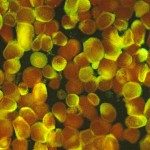Lien vers Pubmed [PMID] – 20838433
PLoS ONE 2010;5(9):e12558
BACKGROUND: Pregnancy-associated malaria (PAM) is a serious consequence of the adhesion to the placental receptor chondroitin sulfate A (CSA) of Plasmodium falciparum-infected erythrocytes (PE) expressing the large cysteine-rich multi-domain protein var2CSA. Women become resistant to PAM, and develop strain-transcending immunity against CSA-binding parasites. The identification of var2CSA regions that could elicit broadly neutralizing and adhesion-blocking antibodies is a key step for the design of prophylactic vaccine strategies.
METHODOLOGY: Escherichia coli expressed var2CSA DBL domains were refolded and purified prior to immunization of mice and a goat. Protein-G-purified antibodies were tested for their ability to block FCR3(CSA)-infected erythrocytes binding to placental (BeWo) and monkey brain endothelial (ScC2) cell lines using a flow cytoadhesion inhibition assay mimicking closely the physiological conditions present in the placenta at shear stress of 0.05 Pa. DBL5-ε, DBL6-ε and DBL5-6-ε induced cross-reactive antibodies using Alum and Freund as adjuvants, which blocked cytoadhesion at values ranging between 40 to 96% at 0.5 mg IgG per ml. Importantly, antibodies raised against recombinant DBL5-ε from 3 distinct parasites genotypes (HB3, Dd2 and 7G8) showed strain-transcending inhibition ranging from 38 to 64% for the heterologuous FCR3(CSA).
CONCLUSIONS: Using single and double DBL domains from var2CSA and Alum as adjuvant, we identified recombinant subunits inducing an immune response in experimental animals which is able to block efficiently parasite adhesion in a flow cytoadhesion assay that mimics closely the erythrocyte flow in the placenta. These subunits show promising features for inclusion into a vaccine aiming to protect against PAM.


